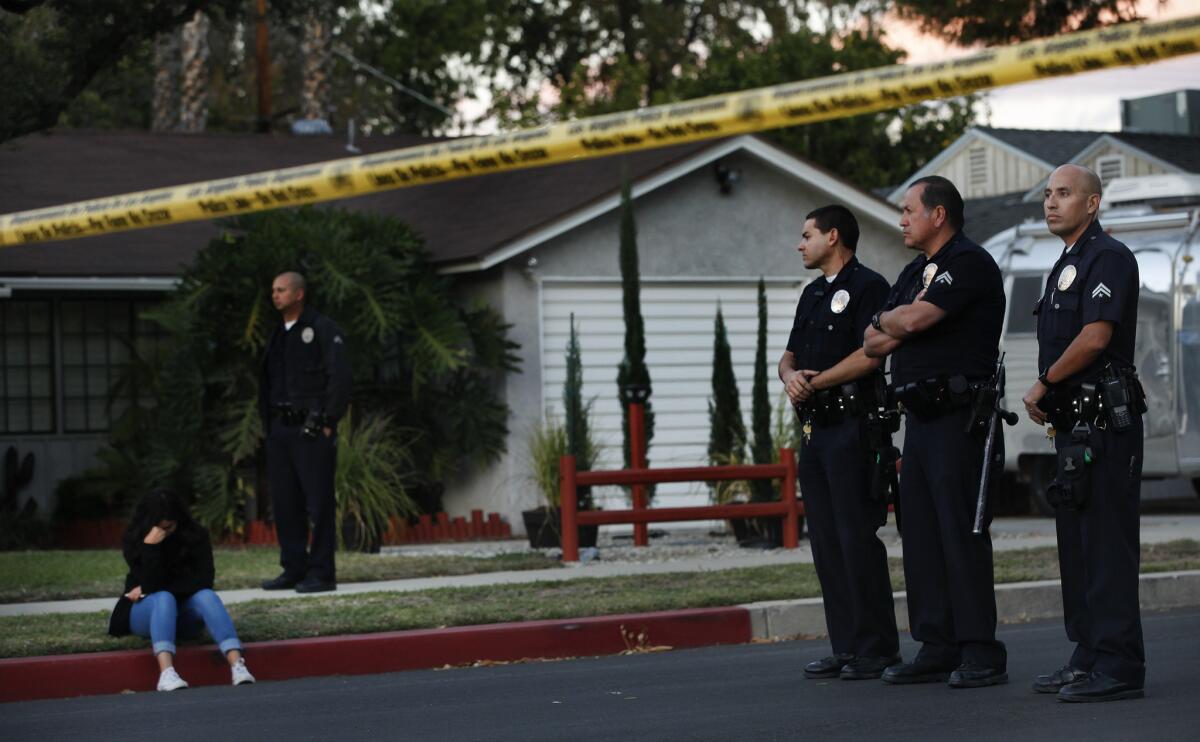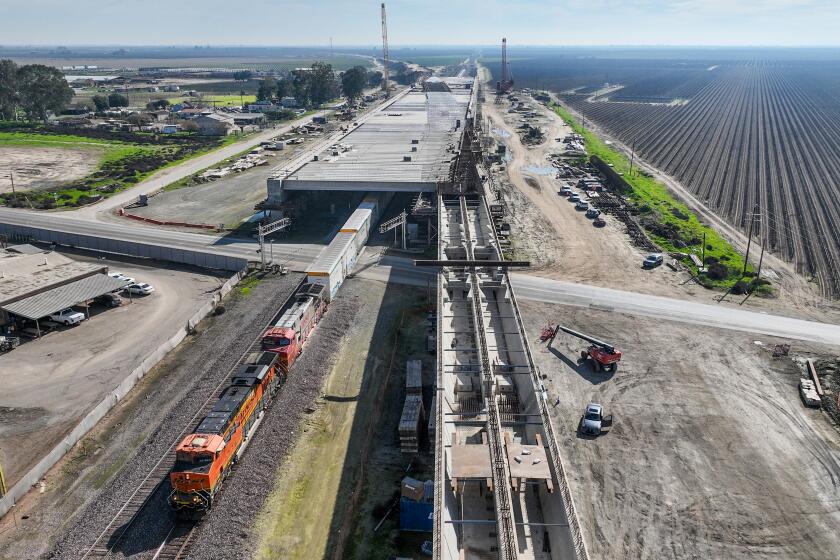LAPD policy needs to be revamped to further limit deadly force, commissioners say

Los Angeles police officers stand near the scene of a shooting last fall in Lake Balboa, where police fatally shot a 34-year-old man.
- Share via
Two Los Angeles police commissioners called Friday for significant changes in the LAPD’s rules on when officers can use deadly force and recommended that the department specifically evaluate whether officers could have done more to defuse tense encounters.
The commissioners proposed revamping the Los Angeles Police Department’s policy to further emphasize that officers should seek ways to avoid using significant force whenever possible, part of the commission’s effort to reduce the number of police shootings and other serious incidents.
If approved, the proposals could have a far-reaching impact on how the five-member Police Commission determines whether officers involved in fatal encounters were justified in using deadly force. By including specific language about so-called de-escalation strategies in department policy, the police chief and commissioners would have to consider whether officers could have tried to avoid using deadly force.
The recommendations build on de-escalation training that was rolled out departmentwide in recent months amid a heated national conversation about how and when officers use force, particularly against African Americans.
The LAPD’s current force policy says officers should be guided by a “reverence for human life,” but Commission President Matt Johnson said the recommendations go further by
articulating the importance of trying to avoid using force.
“That can’t just be words on a page,” said Johnson, one of two commissioners who crafted the proposals, which were included in a report released Friday. “The importance of de-escalation needs to be emphasized throughout every facet of the organization.”
Johnson stressed that de-escalation might not be possible in every situation, and said the policy would require officers to try such strategies only “when reasonably practical.”
“This is in no manner meant to decrease officer safety,” he said.
But the president of the union representing rank-and-file officers blasted the proposal, saying it would put officers at greater risk of unfair scrutiny of shootings, even if they were justified in pulling the trigger. President Craig Lally said officers try to avoid firing their guns, but that isn’t always possible during a rapidly unfolding, dangerous situation.
“The best way to de-escalate is to run away,” he said sarcastically. “If you get a guy that’s got a knife, run the other way and hope to God he doesn’t stab somebody else.... The officers should just arrive there, look at the situation, see a gun or a knife and say, ‘You know what, I’m going to get blamed if I shoot.’
“Whether it’s totally justified or not, they’re going to get reamed, they’re going to get second-guessed,” he continued.
“It’s a no-win situation for the officer.”
Law enforcement agencies across the country have recently looked toward de-escalation as one way to improve tensions between officers and residents. Earlier this year, the Police Executive Research Forum issued a report calling on departments to go beyond the current legal standard for using force and update their policies to better incorporate de-escalation strategies.
That prompted backlash from some police officials, who said such proposals were a knee-jerk reaction to public opinion and could threaten officer safety.
Michael Gennaco, a longtime policing consultant, said adopting the type of policies proposed by the L.A. police commissioners could help avoid the “lawful but awful” situations in which officers were legally allowed to use force but “there could have been another way of handling it.”
“Just because you can under the law doesn’t mean you should,” he said.
The L.A. proposals stem from a 22-page analysis by Inspector General Alex Bustamante that evaluated how LAPD policies and training related to the use of force changed over the last decade. Johnson and Commissioner Robert Saltzman outlined a dozen recommendations based on Bustamante’s review.
The commissioners’ input is the latest indicator of the panel’s increasingly hands-on approach in recent months to overseeing the 10,000-officer LAPD. The full commission is scheduled to discuss the report at its weekly meeting Tuesday, where a majority vote would put the proposed changes into effect.
The changes would also strengthen the commission’s oversight of LAPD training by requiring the department to give commissioners “advance notice of any and all contemplated changes” to training related to de-escalation strategies, interactions with people believed to be mentally ill and the use of lethal and less-lethal weapons.
Police Chief Charlie Beck released a statement saying the department “has been committed to using de-escalation and crisis intervention techniques for many years.” LAPD officials, he said, “look forward to further incorporating these preservation of life principles in our constantly evolving training standards and policies.”
Beck recently signed a special order for a new “preservation of life” award, saying it would recognize officers who used “exceptional tactical skills” and “sound judgment to preserve the life of another during a dangerous encounter.”
Last week, the LAPD released a report that showed that more than a third of the people shot by officers last year had documented signs of mental illness and that African Americans continued to account for a disproportionately high number of people shot.
If enacted, the commissioners’ recommendations would be a “huge step” toward “sharply reducing tensions and mistrust between minority communities and the LAPD,” activist Earl Ofari Hutchinson said. Mayor Eric Garcetti released a statement praising the proposals, saying they could “reinforce officers’ obligations to avoid violent confrontations whenever possible.”
Although de-escalation strategies have drawn increased attention, the concept is not new. A 1986 LAPD training bulletin — distributed under then-Chief Daryl Gates — included the term, reminding officers to use “the minimum force necessary” to take someone into custody.
Friday’s proposals echo language that the commission removed from the LAPD’s force policy seven years ago, according to Bustamante’s analysis. Before then, the department required that “all reasonable alternatives have been exhausted or appear impracticable” before deadly force could be used. Examples of those reasonable alternatives included moving away from someone holding a knife or using a less-lethal device such as a Taser or bean-bag shotgun.
The 2009 change, Bustamante wrote, “implicitly broadened authority for the use of deadly force.”
Geoffrey Alpert, a criminology professor at the University of South Carolina, said the commissioners’ proposals were “spot-on” in making de-escalation an integral part of department policy, training and supervision. The key, he said, would be for officers to be held accountable.
“The best cops think with their heads and not their fists … it reinforces that,” he said. “No chief can say it’s a bad idea.”
For more Los Angeles crime and LAPD news, follow @katemather on Twitter.
ALSO:
‘Dog Whisperer’ Cesar Millan investigated after animal cruelty complaint
A behind-the-scenes battle to divert L.A.’s storm water from going to waste
Is P-22 mountain lion too dangerous for Griffith Park? Koala death sparks debate
More to Read
Sign up for Essential California
The most important California stories and recommendations in your inbox every morning.
You may occasionally receive promotional content from the Los Angeles Times.











